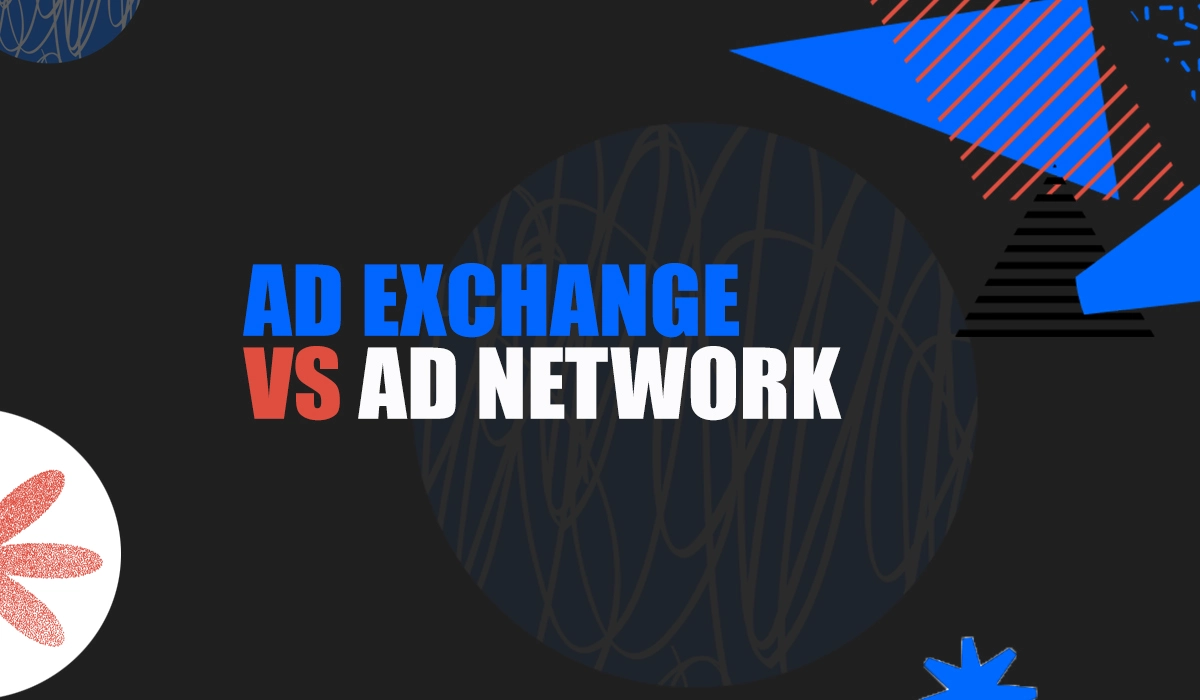Are you familiar with the distinction between an ad network and ad exchange? If not, get ready to learn! Ad Networks vs Ad Exchanges may seem similar at first, but they actually have distinct roles in the digital advertising ecosystem.
Advertising networks gather inventory from multiple publishers, increase its value, and sell it to advertisers for a profit. On the other hand, ad exchanges offer more transparency by allowing advertisers to see the exact price at which publishers’ impressions are sold.
According to Statista, global digital advertising spending in 2021 is estimated to reach $522.5 billion, which is expected to grow to $679.80 billion by 2023. With the growing number of digital advertising options, it’s vital to understand the difference between ad network and ad exchange platforms.
In this post, I’ll delve into the differences between these platforms and discuss why ad exchanges are becoming the preferred choice for publishers. Stay tuned for more!
Table Of Contents
What Are Ad Networks and Ad Exchanges?
Before diving into the specifics, let’s establish a clear understanding of what these two advertising platforms actually are and how they function in the digital advertising landscape.
Ad Networks: The Intermediaries of Digital Advertising
Ad Networks function as intermediaries that connect advertisers with publishers. They serve as a one-stop-shop for advertisers looking to display their ads across multiple websites or applications.
These platforms aggregate ad inventory from various publishers and offer it to advertisers in predefined packages or formats. Unlike Ad Exchanges, Ad Networks may not always operate in real-time and often involve negotiated deals with fixed pricing structures. They typically specialize in specific niches or audience segments, making them attractive for targeted marketing campaigns.
Ad Exchanges: Digital Marketplaces for Real-Time Ad Inventory
An Ad Exchange is the ultimate digital marketplace for buying and selling online advertising inventory. With its automated auction system, you can be sure that you’re getting the best deals in real-time. It acts as a platform where publishers can make their ad inventory available to potential buyers, and advertisers can bid on this inventory to display their ads.
Ad Exchanges operate on a programmatic advertising model, meaning that ad space buying and selling happen automatically through algorithms and real-time bidding (RTB). This creates a more transparent environment where the true market value of ad space is determined through competitive bidding.
Key Differences Between Ad Networks and Ad Exchanges
Ad networks and ad exchanges are both major players in the digital advertising world, but they have some critical differences. Let’s examine the key distinctions that can impact your advertising strategy.
Inventory Control: Who Has the Power?
Ad exchanges give publishers granular control over their ad inventory. They can set floor prices, the minimum prices they’re willing to accept for ad space. Publishers can also target specific audiences based on demographics or interests to ensure their ads reach the right people.
Additionally, publishers can decide which advertisers are allowed to bid on their inventory, allowing them to maintain control over the types of ads displayed on their websites. This level of control helps maintain brand integrity and user experience.
Ad networks, however, have less control over the specific advertisers that display their ads. Ad networks bundle inventory from various publishers, and advertisers may not have as much say in where their ads appear. This lack of control can disadvantage publishers who want to maintain brand integrity or target specific audiences.

Real-Time Bidding: Speed and Efficiency in Ad Exchanges
Ad exchanges operate on a real-time bidding model. This means that advertisers can bid on ad space in real-time auctions. This enables dynamic and instant decision-making based on various targeting parameters.
Advertisers can adjust their bids in real-time to optimize their campaign performance and ensure that their ads are shown to the most relevant audience. This flexibility allows for quick adaptation to market conditions and campaign performance.
In contrast, ad networks may not always operate on a real-time basis. Deals are often pre-negotiated between advertisers and publishers, and advertisers may buy ad space in bulk rather than participating in individual real-time auctions. This can limit the flexibility and immediacy of ad placements for advertisers who need to make quick adjustments.
Transparency and Brand Safety Concerns
Ad exchanges provide more transparency regarding where ads are displayed. Publishers can set controls to ensure brand safety and avoid displaying ads on inappropriate or low-quality websites.
This is achieved through tools like content category blocking, URL blocking, and ad verification services. Advertisers can have confidence that their ads are being shown in a contextually appropriate and brand-safe environment.
On the other hand, ad networks offer less transparency since advertisers may not know in advance which specific websites their ads will appear on. This can pose challenges for brand safety, as advertisers may be concerned about their ads being displayed on websites that do not align with their brand values or could potentially damage their brand reputation.
Scale and Reach: How Wide Is Your Net?
Ad exchanges can offer access to a broader range of inventory from various publishers. This means that advertisers have the potential for a larger reach and can target a wider audience. Ad exchanges often have large networks of publishers, including both premium and long-tail websites, providing advertisers with a diverse set of options to choose from.
Ad networks, on the other hand, may have specific niche audiences or specialized inventory. While this can be advantageous for advertisers who want to reach a specific target audience, it may result in a more limited reach compared to ad exchanges.
Ad networks often focus on specific verticals or genres, such as sports, fashion, or technology, and their inventory may be more tailored to those specific niches. This specialization can be valuable for targeted campaigns but may not serve advertisers looking for maximum reach.

Pricing Models: Dynamic vs. Fixed
Ad exchanges operate on a dynamic pricing model based on real-time bidding. Advertisers bid against each other for ad space, and the highest bidder wins the auction. The winning advertiser pays the market rate for the ad space they have won.
This dynamic pricing model ensures that advertisers pay a fair price based on demand and competition. It also allows publishers to maximize their revenue by capturing the true market value of their inventory.
In contrast, ad networks often involve fixed pricing models or negotiated deals. Advertisers may purchase packages of impressions or clicks at set prices. This can provide more predictability and control over advertising costs for advertisers who prefer a fixed budget, but it may not always reflect the true market value of the inventory.
Data and Targeting Capabilities Comparison
Ad exchanges often have advanced data and targeting capabilities that allow advertisers to reach highly specific audiences. They can leverage user data, such as browsing behavior, demographics, and interests, to target ads to individual users in real-time. This level of granular targeting can result in more effective and personalized advertising campaigns.
The integration of data management platforms (DMPs) and demand-side platforms (DSPs) with ad exchanges enhances targeting capabilities even further. Advertisers can create detailed audience segments and target users based on their online behavior, purchase intent, and other valuable signals.
Ad networks may have limited data and targeting capabilities compared to ad exchanges. They may rely on broader targeting parameters, such as website or content category, rather than individual user-level targeting. This can make it more challenging for advertisers to reach specific demographics or interests with precision.
Ad Format Flexibility and Creative Options
Ad exchanges typically support a wide variety of ad formats, including display ads, video ads, native ads, and more. This allows advertisers to choose the most suitable format for their campaign objectives and creative assets. The flexibility in ad formats enables advertisers to create engaging and interactive ad experiences that resonate with their target audience.
Many ad exchanges also support rich media ads and interactive formats that can drive higher engagement rates. This variety gives advertisers the freedom to experiment with different creative approaches and find what works best for their specific campaign goals.
Ad networks may have limitations in terms of ad formats. They may focus on specific types of ad placements, such as banner ads or text-based ads, which can limit the creative possibilities for advertisers. This may be a consideration for advertisers who want to experiment with different ad formats to capture user attention and drive higher engagement.
Advertiser Control and Campaign Optimization
Ad exchanges provide advertisers with more control and optimization options. Advertisers can set their own budgets, bid strategies, and campaign parameters, allowing them to have complete control over their ad spend and campaign performance. They can also access real-time performance data and make adjustments to optimize their campaigns on the fly.
This level of control allows advertisers to be more agile and responsive to campaign performance. They can quickly identify what’s working and what’s not, and make immediate adjustments to improve results. This real-time optimization capability is a significant advantage in the fast-paced digital advertising landscape.
On the other hand, ad networks may have less flexibility in terms of advertiser control and optimization. Advertisers may need to rely on the network’s optimization algorithms and may not have as much visibility into real-time campaign performance or the ability to make instant adjustments. This can limit the ability to fine-tune campaigns for optimal results and may result in less efficient ad spend.
Ad Network and Ad Exchange: Pros and Cons Face-Off
Let’s compare the advantages and disadvantages of both ad exchange networks and traditional ad networks to help you make an informed decision for your advertising strategy.
| Pros | Cons | |
| Ad Exchange | Precision Targeting: Ad exchanges are best known for their ability to deliver granular and precise targeting. Advertisers can target specific users, devices, locations, and more. Real-time Bidding: Advertisers can bid in real-time and adjust their bids based on how much they are willing to pay for an impression. Access to premium inventory: Ad exchanges offer access to premium inventory from some of the most popular websites and publishers. | High learning curve: Ad exchanges are complex, and it can take time to understand and become proficient in using them. Higher CPMs: Ad exchanges operate on a bidding system, and many advertisers bidding for the same ad space can drive up the cost per thousand impressions (CPMs). |
| Ad Network | Easy to Use: Ad networks are easy to use and do not require extensive knowledge of the digital advertising industry. Wide Reach: Ad networks can offer access to a broad range of websites and publishers, allowing advertisers to reach a vast audience. Cost-effective: Ad networks use bulk buying power to reduce the cost of ad space, making it a cost-effective option for advertisers. | Lack of Control: Advertisers have less control over where their ads appear compared to ad exchanges. Limited Targeting: Ad networks offer targeting options, but they are not as granular as ad exchanges. Fraudulent Traffic: Ad networks are at risk of fraudulent traffic and may not always deliver high-quality impressions. |
How to Choose Between Ad Networks and Ad Exchanges in 2025
The decision between using an Ad Exchange or an Ad Network depends on your specific advertising goals and requirements. Consider these key factors to make the right choice for your business:
Granularity of Control: If you require precise control over where your ads are displayed and want to set specific targeting parameters, an ad exchange network may be the better choice.
Real-Time Requirements: For campaigns that require dynamic, real-time decision-making, especially in programmatic advertising, an Ad Exchange is likely the preferred option.
Brand Safety Concerns: If brand safety is a top priority, Ad Exchanges provide more transparency and control over ad placements, helping you protect your reputation.
Budget and Scale: Ad Exchanges can provide access to a larger pool of inventory, which can be beneficial for advertisers looking for maximum reach. However, Ad Networks may offer a specialized inventory that aligns with specific niche audiences.
Here are some additional considerations to help you make your decision:
- Your technical capabilities and resources
- Campaign goals (brand awareness vs. direct response)
- Target audience specificity
- Budget constraints and flexibility
- Need for real-time optimization
The Future of Ad Exchanges and Networks in Digital Advertising
The digital advertising landscape continues to evolve rapidly, with several trends shaping the future of both ad exchanges and networks:
- AI and Machine Learning: Advanced algorithms will further enhance targeting capabilities and campaign optimization
- Privacy-First Advertising: With the phasing out of third-party cookies, contextual targeting will become more important
- Connected TV and Digital Audio: These channels are growing rapidly and offering new inventory opportunities
- Blockchain Technology: May increase transparency and reduce fraud in digital advertising
- Consolidation: Larger platforms may continue to acquire specialized networks and exchanges
As these trends develop, both ad exchanges and networks will need to adapt. The platforms that can offer the best combination of targeting capabilities, transparency, and user privacy compliance will likely lead the industry in the coming years.
Final Thoughts
Ad Networks and Ad Exchanges each offer unique benefits and limitations. The decision of which to use ultimately comes down to an individual business’s advertising goals, budget, and expertise.
Consider the options carefully, do your research, and work with a reputable partner to help ensure your success in the world of digital advertising. With the right approach and strategy, online advertising can be an incredibly powerful tool for reaching new customers and growing your business.
Take your time, do some research, and team up with a trusted partner like Bizzoffers.com to ace the digital advertising game. Effective media buying in marketing requires understanding the nuances between these platforms to maximize your ROI.



